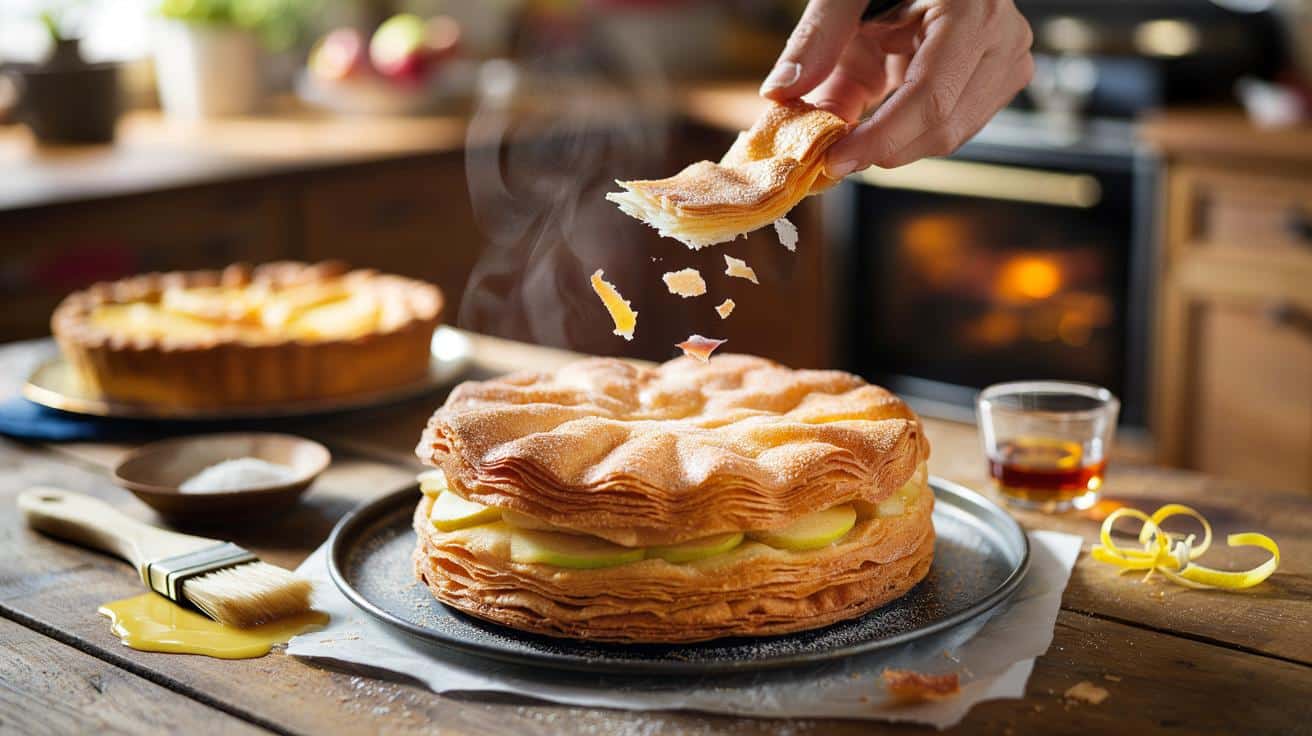Families want bite, lightness and a little theatre at table.
The crackle of a thin, sugared crust has begun to replace the soft sigh of apple pie. From Bordeaux flats to suburban semis, a regional pastry from Gascony is moving centre stage. It brings ritual, noise and freshness after rich meals. It also uses humble ingredients, simple kit and a hot oven shelf.
What croustade is, and why it feels new
The Gascon croustade is a layered pastry built from paper-thin sheets. Each sheet is brushed with melted butter and a dusting of sugar. The bundle wraps soft fruit, most often apples scented with lemon and a nip of Armagnac or rum. The result is a lacquered top that fractures at the touch and a tender core that stays bright.
It lands differently to pie. There is no thick base. There is no heavy custard. The first impression is sound, then aroma, then warmth. It looks handmade even when produced in a pro bakery. It travels well for birthdays, school fairs and Sunday lunches.
The sound sells it before the taste. Texture beats sweetness, and the crunch turns dessert into an event.
Parents say the making is half the fun. One person peels. One stirs sugar. One stretches the dough across a sheet like silk. Children love the theatre. Adults love the clean finish after roast chicken or daube. A tray returns with more corners missing than slices taken.
From Gascony to your oven: the method behind the crackle
A classic dough takes flour, a whole egg, neutral oil, water, a tiny pinch of salt and a trickle of white vinegar. The mix needs a firm knead until elastic. Resting for one to two hours unlocks stretch. A floured cloth on the table stops sticking. The dough rolls to plate size, then stretches by hand from the centre out until you can read the wood grain below.
- Rest the dough longer than you expect; thinness comes from patience and elasticity.
- Brush lightly with butter between sheets; add a thin veil of sugar for gloss and snap.
- Toss apples with lemon zest and a spoon of Armagnac or rum; cool them before assembling.
- Bake on the lower shelf at 200–210°C on a preheated tray; rotate once for even colour.
- Keep fruit in a modest layer; steam needs escape routes to safeguard crisp layers.
Short on time? the phyllo route
Good-quality phyllo or brick pastry makes a fine shortcut. Stack five to eight sheets, brushing each one with butter and a sprinkle of sugar. Scatter the fruit, ruffle the edges loosely over the filling, brush again and bake hot. Tap the top; it should sound brittle and look like a crumpled sunrise.
Hot shelf, hot tray, thin fruit, cool filling: that quartet protects the shatter.
Common pitfalls are easy to fix. Overfilling turns crisp to soggy. Warm fruit wilts layers. Too much liquor muddles flavour and softens structure. If the top colours too fast, tent with foil and keep heat driving from below.
Bakeries and families report a shift
Weekend counters show the change. In Toulouse, a cousin brings one croustade to a birthday and the next week two are requested. In Lyon, a Friday “minute croustade” draws a queue by late afternoon. Clips of bakers stretching dough like glass thread rack up comments nationwide. At autumn fêtes, the apple tart stall now shares space with a mountain of ruffled pastry. People lean in, break a shard, then fetch a friend.
The trend taps several currents. Texture has returned to fashion. People want desserts that feel light but deliver drama. Price and practicality matter during tight months. A croustade’s shopping list sits in most kitchens: flour, sugar, butter, apples, a splash of something fragrant. The rest is time and a hot oven.
| Feature | Apple pie | Gascon croustade |
|---|---|---|
| Base | Thick pastry, holds juices | Paper-thin sheets, no dense bottom |
| Texture | Soft crumb and tender top | Shattering crust, airy bite |
| Flavour notes | Cinnamon, buttered crust | Browned butter, lemon zest, Armagnac or rum |
| Serving moment | Comfort pudding after hearty meals | Festive centrepiece that stays light |
| Audience appeal | Assured classic, familiar shape | Novel ritual, audio-visual thrill |
Why the crunch wins hearts across France
French tables care about texture as much as taste. Croustade meets that demand with sound, contrast and heat. It slices neatly. It feeds a crowd without rich sauces. It welcomes pears in November, apricots in June and prunes when winds rise. It wears regional identity proudly while slipping into any oven with equal ease.
There is a social effect as well. The ritual pulls people from sofa to kitchen. Stretching dough looks brave but becomes addictive after the first success. The act feels shared. That matters in homes where dessert is as much about gathering as it is about sugar.
One tray, three roles: peel, stretch, brush. Hands meet over the table; the pastry brings them there.
Make it work every time
Choose a mix of apples for balance: tart Granny Smith with sweet Golden or Pink Lady. Keep the liquor restrained; a spoon lifts aroma without wetting the pastry. Bake low in the oven, close to the heat source, and give the tray a quarter-turn mid-bake. Rest the croustade for ten minutes so steam settles and layers firm. Re-crisp leftovers in a warm oven for five minutes; the microwave kills crunch in seconds.
Costs, convenience and seasons
Ingredients are modest. Butter counts most; buy the best you can. The method is repeatable, and leftovers stay appealing because the crisp returns with a short reheat. Croustade also travels better than cream desserts on bumpy bus rides to grandparents. It holds up at room temperature and still delivers drama when the knife goes in.
Seasonality keeps it interesting. Apples carry the colder months. Pears add fragrance in late autumn. Apricots bring sour-sweet juice to early summer. Prunes bring depth when days are short. A squeeze of lemon or a scrape of vanilla ties changes together without fuss.
Practical extras for readers
Worried about alcohol for children? Swap Armagnac for apple juice reduced with lemon zest; the citrus brightens flavour without adding liquid weight. Cooking gluten-free? Use phyllo made with alternative flours and handle it with care; it dries quickly, so keep sheets covered with a damp tea towel until needed.
Want a make-ahead plan? Assemble and chill for up to two hours. Bake just before serving to keep the snap. If you need to transport, bake slightly pale, then finish in a hot oven for three minutes on arrival. For waste-free kitchens, turn trimmings into sugared crisps: brush, sprinkle, bake at 200°C for five minutes, and serve with coffee.
Thinking about nutrition and balance? Croustade eats in small, satisfying portions because the texture delivers impact fast. Pair slices with unsweetened yoghurt and a few toasted nuts for a dessert that feels complete without excess. If you host regularly, set up a simple “three-bowl” station—fruit, butter, sugar—and invite guests to help build the layers. The performance becomes part of the evening, and the result tends to vanish, sheet by sheet.








